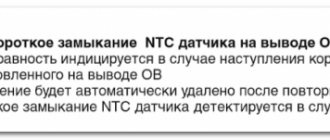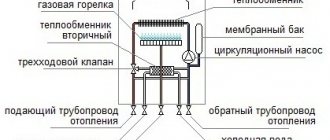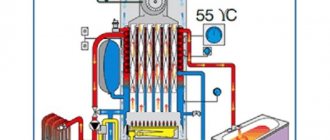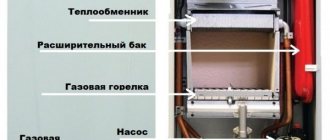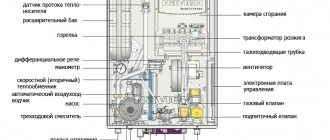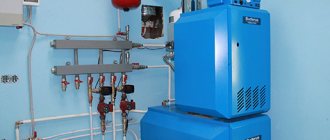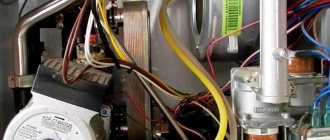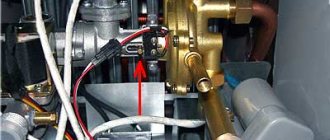Efficient and reliable Baxi heating equipment will provide you with heat and hot water. Italian equipment is economical, environmentally friendly, accurate and silent. A well-thought-out security system is triggered in critical situations. In this case, errors may appear on the boiler display. Below you will learn about the meanings of error codes and typical equipment malfunctions and how to fix the problems yourself.
Error E 01
- A general error indicates that the boiler was unable to ignite the burner in normal mode. The reasons can be very different:
- There is no gas supplied to the boiler (the gas supply valve is closed, the pressure in the main pipeline has dropped, the gas filters are clogged, the gas meter is faulty). As a rule, connecting a gas boiler is connected to a gas stove, therefore, it is easy to check the presence of gas by simultaneously turning on all consumers of the gas stove.
- Some boiler models require connection polarity - this means that phase and zero on the control board must be connected correctly. If a violation occurs, the user will observe the following behavior of the boiler: the boiler burner ignites, but the characteristic crackling sound of the ignition electrode does not stop (the boiler cannot detect that a flame has appeared), after three such attempts, error E 01 will appear. It is quite easy to eliminate this cause - change the position of the plug in the socket to the opposite. If this manipulation does not lead to a positive result, most likely the control unit really does not see the flame and the board requires repair.
- Problem with the flame control sensor. To ensure safe operation, the boiler must constantly monitor the presence of a flame on the burner. A special sensor (ionization electrode) is responsible for this. In some boilers it is structurally designed separately from the ignition electrode, and in others it is combined. Therefore, when this electrode is dirty (from carbon deposits), frayed and shorted to the boiler body, or poorly connected to the board, there will be problems with ignition. You also need to check the correct position of the electrode relative to the burner and the gap in accordance with the instructions for the boiler.
- There is a problem with the gas valve or its setting. Malfunctions of the gas valve itself are quite rare. Most often, problems can arise with changes in the input parameters of the main gas pressure, for example, when the number of consumers increases at the beginning of the heating season. To diagnose a gas valve, static and dynamic pressure are measured and compared with the manufacturer's recommended values. A typical gas valve contains electromagnetic coils that can cause a breakdown - their diagnosis boils down to measuring the resistance with a tester.
- Control board faulty. If previous checks did not lead to results - the boiler does not ignite or ignites, but goes out or the combustion is unstable, then the reason may be a malfunction on the control board. In this case, you can either check the operation of the boiler with a known-good unit, or give the board to a specialist for diagnostics.
Features of operation and diagnostics
Baksi boilers have some features that distinguish them from other similar devices and which are an undoubted advantage during operation.
- Adjustable flame, gradual ignition. First, the burner heats up the combustion chamber at minimum power for one minute, then it switches to the level set by the electronics.
- The temperature control sensor maintains the flame power required for the set mode. Thanks to this, the number of on-off cycles is reduced, and wear on the injectors, combustion chamber, and coils is reduced. As a result of all this together, the service life of the unit increases.
- Reduced gas and electricity consumption thanks to the post-circulation system. The coolant continues to circulate even after the burners are turned off until a signal is received from the electronics to reduce the temperature.
- Double temperature control. This means that you will be able to control the boiler not only from the room where it is installed, but also outside, using additional sensors installed there.
- Small dimensions and weight. Possibility of connecting both wall and floor models according to standard circuits, depending on the conditions. This minimizes the occurrence of faults and ensures ease of troubleshooting.
- The operating instructions for Baksi gas boilers indicate that they can be used in conjunction with boilers of a similar brand to obtain better results.
- Flexible control system thanks to direct connection of control electronics.
- Stable operation of the boiler under pressure changes of water and gas.
Diagnostics and adjustment of boiler operating parameters is carried out only by specialists after installing the boiler in the room using an electronic display and control buttons. All boiler malfunctions have their own codes, thanks to which you can determine the type of malfunction and, accordingly, choose a method to eliminate it. Floor-standing units are sensitive to improper installation, which will also cause increased noise during operation, popping noises at the moment of ignition, etc.
Error E 02 - the emergency overheating thermostat has tripped
The thermostat is a sensor that is located on the outlet pipe from the main heat exchanger of the boiler and is designed to block the boiler if the coolant boils. This is a mechanical sensor whose contacts close when the maximum temperature is reached.
Overheating (boiling) of the boiler is most often caused by poor circulation of the coolant (filters are clogged, the heat exchanger is overgrown with scale, air in the heating system) or problems with the circulation pump. At the same time, boiler boiling is most often accompanied by a characteristic crackling sound in the area of the primary heat exchanger. If there is in fact no overheating, then you should look for the problem in the sensor itself: poor contact with the control board or a breakdown. You can check the sensor very simply with a tester: remove the sensor connector; at temperatures below 90 degrees, the contacts should be closed.
In case of real problems with circulation and overheating, the NTC temperature sensor of the heating system is usually triggered first (records a too rapid rise in temperature).
Clocking of a Baxi double-circuit gas boiler in DHW hot water supply mode
Either cold or hot water comes from the boiler.
The operating manual for the Baxi double-circuit gas boiler states that with the factory settings for a maximum power of 24 kW, the boiler provides water heating for a temperature difference of dT = 35 °C, with a maximum hot water flow of 9.8 l /min.
In a house with a boiler connected to the central water supply, the following results of measuring the maximum hot water flow were obtained: through the bath mixer horn 6 l/min, in the washbasin 4 l/min, in the kitchen sink 5 l/min.
You can find out the maximum flow of hot water in the taps yourself if you use the information menu of the Baxi Main Four boiler. Open the hot water taps one by one and observe the flow rate in the information menu, Line A08 : current value (l/min x 10) of domestic hot water flow.
Usually, in order to save money, users do not open the water taps to full flow.
Obviously, the difference between the factory settings for the maximum boiler power in DHW mode, designed to heat 9.8 liters per minute, and the power required to heat the actual flow rate at the tap, will be significant.
This leads to cyclical (clocking) heating of hot water. The boiler burner in DHW mode periodically turns on and goes off. Accordingly, either cold or hot water comes out of the tap.
For comfortable use of hot water, it is necessary to adjust the boiler power in DHW mode . This can be done through the service menu. Line F09 - maximum useful power of the DHW system (0-100%). Line F16 - minimum useful power of the DHW system (0-100%).
Read more: Either cold or hot water comes from the boiler
Error E 10 - unacceptable pressure in the heating system.
In most cases, BAXI boilers use a minimum pressure switch. This is a sensor that closes when the set pressure of the heating system is reached and accordingly opens when it is insufficient. Therefore, in most cases it is necessary to check the readings of the mechanical pressure gauge and sign the boiler. How to do this - read in a separate article on error E10 on Baxi boilers.
Error E 12 and Error E 13
- the same as E10 for Nuvola-3, Nuvola-3 Comfort boilers.
The cause of error E13 may be an incorrect configuration of the control board (for ECOFOUR boilers).
Error E 25
– too rapid temperature rise in the heating system The temperature sensor of the heating system is installed, like the safety thermostat, at the outlet of the primary heat exchanger. Accordingly, if the temperature at the sensor rises rapidly (at a rate of more than 1 degree per second), you need to either look for the cause of poor coolant circulation or check the serviceability of the sensor itself.
Error E 26
– the temperature rise on the heating system sensor is more than 20°C relative to the set one.
The reason is either a malfunction of the temperature sensor (measure the resistance), or the presence of actual circulation problems.
Error E 31
– there is no exchange between the board and the remote control panel (for boilers with a remote control panel).
Error E 35
– parasitic (intermittent flame).
In the vast majority of cases, error E35 does not indicate the actual presence of a malfunction. This error practically does not occur on Bertelli&Partners boards. Honeywell boards have a more sensitive flame control circuit design and therefore, under certain humidity conditions, the board begins to produce such failures. Most often, the problem is eliminated by treating the board with isopropyl alcohol and thoroughly drying it. You can read more in the material on error E35.
Error E 96
– associated with reduced supply voltage (less than 170 Volts). If it occurs frequently, you need to think about purchasing a voltage stabilizer.
BAXI gas boiler service menu commands
In the service menu lines you can change some settings for the operating mode parameters of the Baxi gas boiler.
BAXI Main Four | BAXI Eco Four | BAXI Four Tech:
Line F06 - setting the maximum temperature (°C) of the heating system: 00 = 76°C (burner switches off at 80°C); 01 = 45°C. Factory setting = 00.
Line F08 - maximum net power of the heating system (0-100%): 80 - natural gas; 100 - liquefied gas. Factory setting = 80.
Line F09 - maximum useful power of the hot water supply system (0-100%): 80 - natural gas; 100 - liquefied gas. Factory setting = 80.
Line F10 - minimum useful power of the heating system (0-100%): 20 - natural gas; 00 - liquefied gas. Factory setting = 20.
Line F11 - burner waiting time between two starts (01-10 min): 00=10 sec. Factory setting = 03.
Only BAXI Main Four:
Line F14 - test to check the correct position of the hot water sensor: 00 - off; 01 - always on. Factory setting = 01.
Line F16 - minimum useful power of the hot water supply system (0-100%): 20 - natural gas; 00 - liquefied gas. Factory setting = 20.
BAXI Main 5:
Line F06 - Setting the maximum supply water temperature to the heating circuit (°C) 000=76 °C (burner shutdown at 81 °C) 001=45 °C (burner shutdown at 50 °C). Factory setting =000.
Line F08 - Max. power in heating mode (0-100%). Factory setting for boiler model 24F =055; for model 18F =100; for model 14F =050.
Line F09 - Max. power in DHW mode (0-100%). Factory setting =100.
Line F10 - Min. power in heating and hot water mode (0-100%). Factory setting =100.
Line F11 - Waiting time before turning on again in heating mode 000=10 seconds - 001...010 = 1...10 minutes. Factory setting =003.
Line F14 - Checking the correct position of the DHW sensor: 000=Disabled; 001=Always on. Factory setting =001.
Line F18 - Unlocking parameters for SERVICE. Factory setting =000.
I recommend recording all settings changes you make in the menu lines. Attach the notes to the instructions for the boiler.
Advice
By connecting the Baksi boiler to the network via a UPS, the risks of heating equipment stopping with errors due to instability of the supply voltage are eliminated. Another plus is that the unit, unlike a standard stabilizer, will ensure uninterrupted autonomous operation of the unit in the event of power line breaks due to the built-in (external) batteries. For suburban properties, the best option is to electrically connect a Baksi boiler.
“Through zero” circuit for a heating boiler from an uninterruptible power supply
Advice
Self-repair of the mechanical part is possible, but it is more advisable to replace the pump if the cause of the E26 error is in it. It is inexpensive, but restoring functionality is not easy, as users write on the forums. Replacing the same impeller is not difficult, but it also needs to be centered, which is something that home-grown “experts” are silent about. The support bearing is the only part that will not cause any difficulties. And one more nuance. Error E26 appears when the internal channel of the Baksi boiler pump, through which air is discharged, is clogged with tiny suspensions. To clean it, you will have to disassemble the device. The difficulty is in repeating the actions in reverse order. It is not a fact that a self-assembled pump will work as it should.
How does a circulation pump work?
Air in the circuit
Difficulties in moving the coolant are caused by airing in the system. You should check by touch the degree of heating of pipes and heating radiators. At the same time, see if there are any puddles on the floor - a leak will initiate overheating and error E26 of the Baksi boiler.
A cooling battery will indicate a problem area in the circuit. It is recommended to bleed air manually wherever it is provided, regardless of automatic valves - they do not always work, especially after long-term operation. The accumulation of bubbles, which impairs the circulation of liquid, also occurs in the Baksi boiler pump, which causes error e26. You need to bleed it out too.


